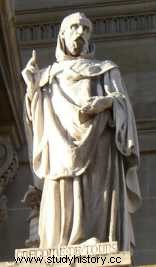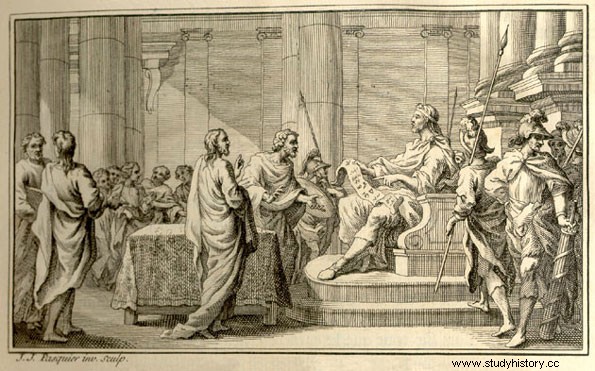 The data we have on the life of Gregory of Tours appears mostly collected throughout the works of the. Born in the year 538 or 539 AD. in Auvergne, what is now Clermont-Ferrand, his father belonged to a Gallic senatorial family. Despite the fall of the Roman Empire, these families (from which provincial governors, judges, or senior magistrates came) proudly retained their title. He received a more careful education than was usual at the time, first by his uncle Gallus, Bishop of Clermont, and then by his uncle Nizier, Bishop of Lyon. In the year 563 he was ordained a deacon and settled in Brioud. After a pilgrimage to San Martín de Tours he was appointed, at the age of 34, bishop of this town, a position he held for the rest of his life. He passed away on November 17, 594 AD.
The data we have on the life of Gregory of Tours appears mostly collected throughout the works of the. Born in the year 538 or 539 AD. in Auvergne, what is now Clermont-Ferrand, his father belonged to a Gallic senatorial family. Despite the fall of the Roman Empire, these families (from which provincial governors, judges, or senior magistrates came) proudly retained their title. He received a more careful education than was usual at the time, first by his uncle Gallus, Bishop of Clermont, and then by his uncle Nizier, Bishop of Lyon. In the year 563 he was ordained a deacon and settled in Brioud. After a pilgrimage to San Martín de Tours he was appointed, at the age of 34, bishop of this town, a position he held for the rest of his life. He passed away on November 17, 594 AD.
Gregory of Tours was active in Frankish political life, especially after the death of King Sigobert I of Austrasia and Auvergne. He acted as a mediator in the dynastic conflicts unleashed after the king's death between Childebert (son of the deceased king), Chilperic (king of Paris), later assassinated, and Gontrán (king of Burgundy). As he tells us, it was his good work in the negotiations that allowed an agreement to be reached. Through the Treaty of Andelot, Gontran adopted Childebert as his successor and in this way the hostilities between the two ended.
The most important work of Gregory of Tours is the History of the Franks (although this title was given to him in the 18th century as his original name was Decem Libri historiarum ). He also wrote Septem Libri Miraculorum , in which he relates a set of miraculous events of saints of the time; Vitae Patrum , where he collects the lives of twenty-three saints from the fourth to sixth centuries AD; and De Cursu Stellarum , a work on the movement of the stars that, despite its title, has no astronomical interest and was written as a liturgical guide.
The History of the Franks It is made up of ten books and aims to recount universal history, from Genesis to the events that occurred before the author's death. The distribution is methodical, at least in appearance:each book, which begins with an index, is divided into chapters and the first four include a chronological relationship. But once the reading begins, the asymmetry of the content of its chapters is verified.
The first four books condense the story that goes from the Creation to the death of Sigoberto (575 AD), while the fifth and sixth deal with events that took place between the years 575 and 584. The remaining four cover the period from 584 to 591. Its elaboration was almost parallel to the development of events since it was written between the years 576 to 590.
 Saint Gregory of Tours, despite being one of the most enlightened men of his time, is unaware of the historiographical technique of his predecessors. The facts are collected without any critical spirit and a large part of the work is based on the memories of the author himself, a contemporary of those. The lack of rigor in the content does not imply, however, that he neglected its elaboration. He takes into consideration written sources that he cites, reproduces or summarizes and even makes an effort to contrast them. In the same way, some quotes from Sallust, Virgil or Pliny and eyewitness accounts of the acts described appear. He even acknowledges and thus indicates that he does not have all the possible data. Despite all this, the importance of the History of the Franks lies in being the best testimony of a dark age.
Saint Gregory of Tours, despite being one of the most enlightened men of his time, is unaware of the historiographical technique of his predecessors. The facts are collected without any critical spirit and a large part of the work is based on the memories of the author himself, a contemporary of those. The lack of rigor in the content does not imply, however, that he neglected its elaboration. He takes into consideration written sources that he cites, reproduces or summarizes and even makes an effort to contrast them. In the same way, some quotes from Sallust, Virgil or Pliny and eyewitness accounts of the acts described appear. He even acknowledges and thus indicates that he does not have all the possible data. Despite all this, the importance of the History of the Franks lies in being the best testimony of a dark age.
The purpose of the History of the Franks , beyond what I express at the beginning of the book, is not to elaborate a universal history as such, but to achieve a specifically pastoral goal. He uses contemporary history as an element of persuasion. Words have much less moralizing force than facts and facts have a greater capacity to "make believe." The presence of God in it is constant and religious approaches appear on numerous occasions throughout the book. The supernatural -
Gregory de Tour's vision of history is the confrontation between good and evil. In his work, he collects both miraculous and beatific events and cruelties, although he usually gives priority to extraordinary events, since both are perfectly normal in human behavior. When he recounts cruel or bloodthirsty acts, the author does not make a value judgment, he limits himself to exposing them. It will be God who judges them.
The works of Gregory of Tours are written in a simple and direct language. Knowing who will be the recipients of it, he uses plain and clear terminology so that his pastoral mission can reach a wider circle. The History of the Franks It is conceived as a great catechesis, from which to teach the faithful what behaviors they should follow, through the example of the contemporary.
If the work of Gregory of Tours stands out for anything, it is for unconsciously reflecting the transition from the Roman Empire to the Middle Ages. The vulgar Latin with which it is written loses its elegance and depth, and already begins the turn towards romance. The decline of Roman institutions is reflected in the internal battles of the new Frankish kings, whose cruelties are recounted unceremoniously, as usual. The absence of critical reflection and the simplicity of the story show how even the most educated men had fallen into mediocrity.
